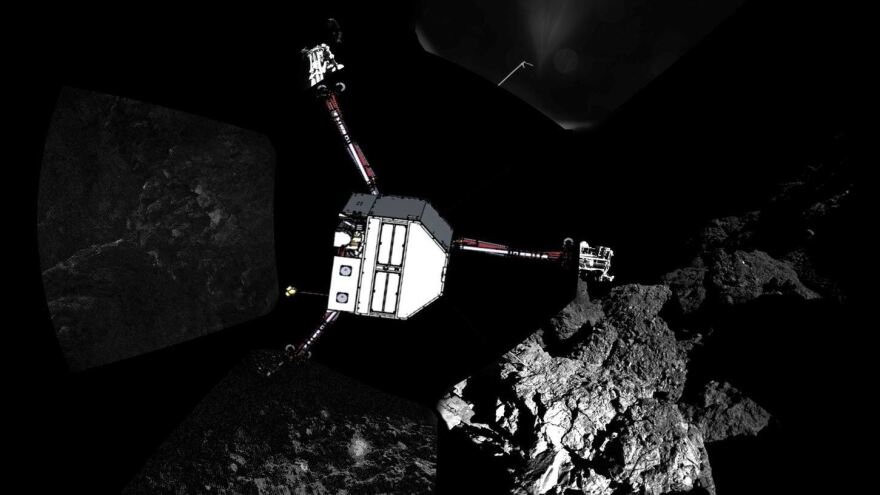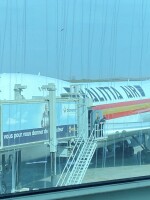The European Space Agency released a new photo Thursday of the Philae lander safely resting in its new home on the surface of Comet 67P/Churyumov-Gerasimenko, as it hurtles through space. The agency's data also show the lander bounced twice before coming to rest.
Wednesday's historic landing came after hours of tension, as the ESA awaited signs from Philae and its parent craft, the orbiter Rosetta, that the robotic lander had arrived on the comet's surface and was able to function.
But even as the ESA's scientists and engineers celebrated their achievement, they also began trying to puzzle out new technical challenges.
Update at 12 p.m. ET: Panoramic Image Released

A new panoramic image suggests the Philae lander may have come to rest on its side. The ESA released that image Thursday, showing the craft's three feet.
To illustrate how Philae is oriented, the agency superimposed a sketch.
Update at 10 a.m. ET: Finding The Lander, And Using It
The Philae lander bounced right out of its planned landing zone, the ESA says. And engineers are also worried that its solar panels could be too shaded to allow it to recharge its batteries.
In a news conference Thursday, the agency said that when the lander bounced — a process that took more than two hours — the comet rotated beneath it. We'll remind you that the comet's diameter is about 4 kilometers, or 2.5 miles. So when Philae came down, it was as much as 1 kilometer from the first touch-down site.
The ESA also released more images of the comet's surface, including one that shows that the area Philae initially came down in looks tailor-made for the probe, smooth and relatively free of obstructions.
What a shame, the first touchdown site was PERFECT. But then the comet lander bounced. #CometLanding #BigBounce pic.twitter.com/4BQi512Jxb
— Geoff Brumfiel (@gbrumfiel) November 13, 2014
The ESA team is also working to locate precisely where the lander is, using images from the Rosetta orbiter. It's possible that Philae came to rest at an odd angle.
"We'll find the lander," said Holger Sierks, principal investigator of the science cameras aboard Rosetta.

Noting that "8 out of 10 scientific instruments are returning data" from the lander, NPR's Geoff Brumfiel says on Twitter, "They are going to learn a lot from this lander."
Our original post continues:
Brumfiel reports:
"Soon after the lander touched down yesterday, scientists realized they had a problem. A pair of harpoons designed to tether the probe to the surface of the comet never fired.
"The probe weighed more than 200 pounds when it was on Earth, but on the comet, it weighs about as much as a sheet of paper. So with nothing to hold it down, it bounced.
"Data now shows the first bounce took more than two hours. A second bounce lasted just a few minutes.
"The first photo from the surface showed the lander's leg next to a rugged-looking outcropping of rock or ice. It is humanity's first view from the surface of a comet."
Copyright 2020 NPR. To see more, visit https://www.npr.org.



